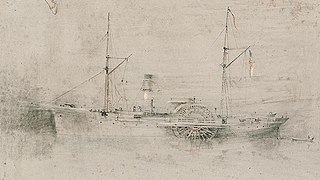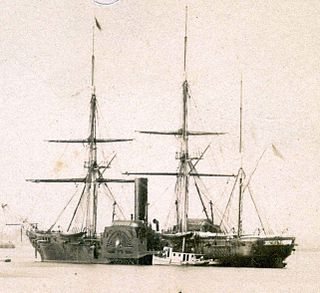
The first USS Pawnee was a sloop-of-war in the United States Navy during the American Civil War. She was named for the Pawnee Indian tribe.

USSKeystone State was a wooden sidewheel steamer that served in the Union Navy during the American Civil War.

USS Susquehanna, a sidewheel steam frigate, was the first ship of the United States Navy to be named for the Susquehanna River, which rises in Lake Otsego in central New York and flows across Pennsylvania and the northeast corner of Maryland emptying into the Chesapeake Bay.

USS Stars and Stripes (1861) was a 407-ton steamer acquired by the U.S. Navy and put to use by the Union during the American Civil War.

The first USS Monticello was a wooden screw-steamer in the Union Navy during the American Civil War. She was named for the home of Thomas Jefferson. She was briefly named Star in May 1861.

The first USS Seminole was a steam sloop-of-war in the United States Navy during the American Civil War.

The second USS Louisiana was a propeller-driven iron-hull steamer in the United States Navy during the American Civil War.
USS Albatross (1858) was a screw steamer rigged as a three-masted schooner acquired by the Union Navy during the beginning of the American Civil War. She was outfitted as a gunboat with heavy guns and used in the Union blockade of the waterways of the Confederate States of America.

USS Unadilla was a Unadilla-class gunboat built for service with the United States Navy during the American Civil War. She was the lead ship in her class.

USS Quaker City (1854) was a heavy, 1,428 long tons (1,451 t) sidewheel steamship leased by the Union Navy at the start of the American Civil War. She was subsequently purchased by the navy, outfitted with a powerful 20-pounder long rifle, and assigned to help enforce the Union blockade of the ports of the Confederate States of America.

USS Valley City (1859) was a 190-ton steamer acquired by the Union Navy for service in the American Civil War.
USS Whitehall was a steamer acquired by the Union Navy during the American Civil War. She was assigned blockade duty; however, her condition was not always considered seaworthy, and she was plagued with condition problems.
USS John L. Lockwood (1854) was a steamer acquired by the Union Navy during the American Civil War. She was needed by the Navy to be part of the fleet of ships to prevent blockade runners from entering ports in the Confederacy.
USS Underwriter (1852) was a 341-ton sidewheel steamer that was purchased for military use by the Union Navy during the American Civil War.
USS Shawsheen was a steam operated tugboat acquired by the Union Navy during the American Civil War.

USS Hetzel (1861) was a steamer acquired by the Union Navy during the American Civil War. She was used by the Navy to patrol navigable waterways of the Confederacy to prevent the South from trading with other countries.

CSS Fanny was a small propeller-driven steam tug used by the Confederate States Navy to defend the sounds of northeastern North Carolina in the American Civil War. Originally armed as a gunboat and operated by the Union, she was captured in October 1861 by the Confederate Navy, and later lost at the Battle of Elizabeth City in February 1862. Due to being used as an observation balloon platform, Fanny is sometimes credited with being the first self-propelled aircraft carrier.
USS Fernandina (1861) was a bark purchased by the Union Navy during the American Civil War. She was used by the Union Navy as a patrol vessel, operating in Confederate waterways.
USS George Mangham (1854) was a schooner acquired by the Union Navy during the American Civil War. She was used by the Union Navy as a gunboat in support of the Union Navy blockade of Confederate waterways.
USS T. A. Ward (1861) was a 284-ton schooner was purchased by the Union Navy during the Union blockade of the Confederate States of America during the American Civil War.












